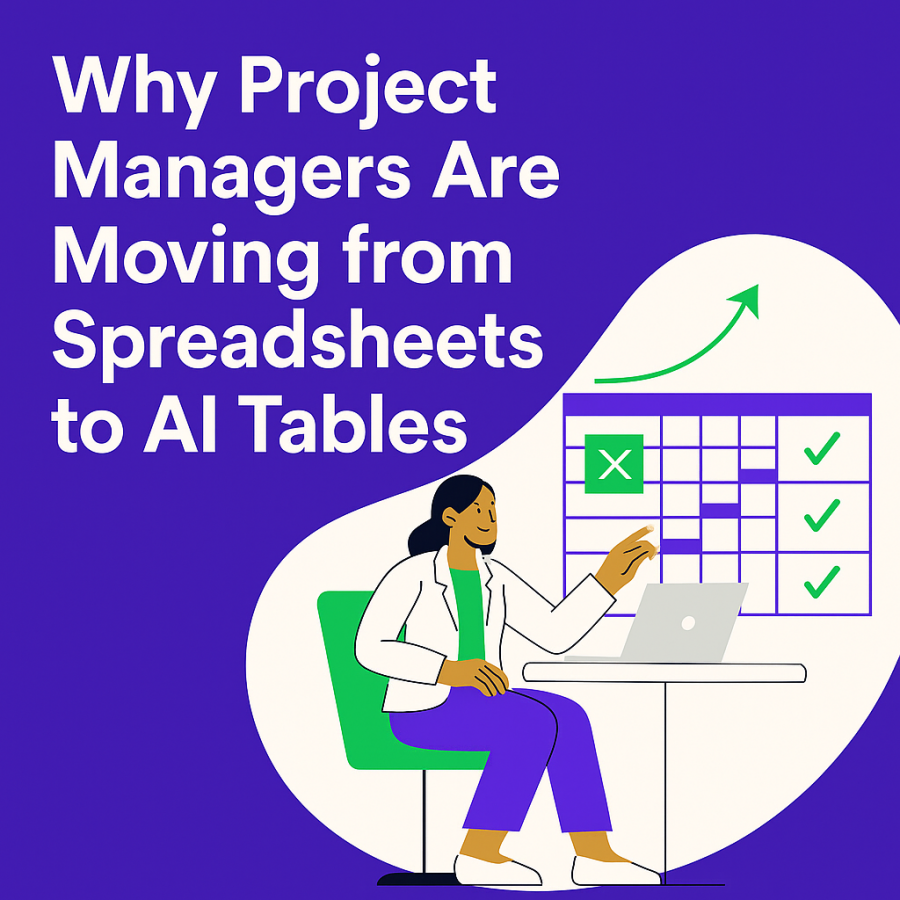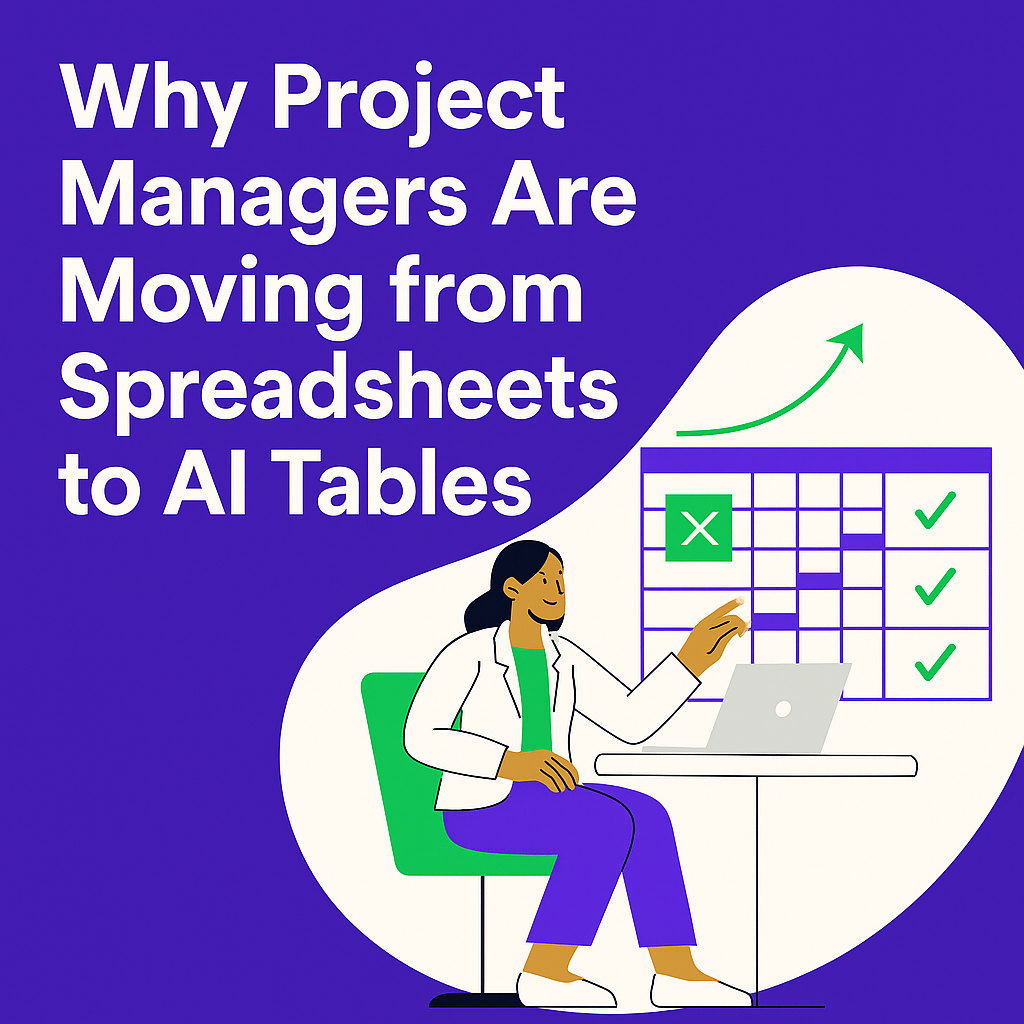In the ever-evolving landscape of project management, the reliance on traditional spreadsheets is waning as innovative AI-powered solutions emerge. As project complexity increases and stakeholder expectations grow, modern project management demands more than manual data-entry tools. Project managers are discovering that AI tables, powered by intelligent automation and seamless collaboration features, offer unparalleled advantages over conventional spreadsheets.
This comprehensive article explores why project managers are migrating from spreadsheets to AI tables, highlights the shortcomings of legacy tools, and provides a deep-dive into how Artavolo—a modern, AI-powered project management software—transforms project planning and execution for the digital age.
Introduction to the Limitations of Spreadsheets in Project Management
Spreadsheets have long been the default tool for tracking project timelines, resource allocation, budgets, and progress. However, as projects become more dynamic and interdependent, spreadsheets reveal inherent limitations:
- Manual Data Entry and Human Error: Spreadsheets are prone to errors due to repetitive and manual data input processes.
- Lack of Real-Time Collaboration: Multiple users editing the same spreadsheet often face version control conflicts, leading to confusion and data inconsistency.
- Limited Automation: Workflow automation is minimal; complex dependencies require manual tracking, increasing the management overhead.
- Scarce Intuitive Visualization: Static tables provide limited insight into project status, making stakeholder reporting cumbersome.
- Difficulty in Scaling: As project complexity grows, spreadsheets become unwieldy and insufficient for managing large datasets or multiple projects.
The growing recognition of these drawbacks motivates project managers to explore innovative alternatives—chief among them, AI-powered project management tools featuring intelligent data tables.
Understanding AI Tables in Modern Project Management
AI tables are a next-generation alternative to traditional spreadsheets, integrating artificial intelligence with robust collaborative platforms to optimize project workflows. Unlike static spreadsheets, AI tables leverage:
- Automated Data Processing: AI can predict deadlines, suggest task assignments, and flag risks based on historical data.
- Dynamic Task Dependencies: Changes automatically cascade through interlinked project elements.
- Interactive Dashboards: Real-time visuals and progress indicators tailored to diverse stakeholder needs.
- Enhanced Collaboration: Commenting, notifications, and simultaneous editing in an integrated environment.
- Integration with Other Tools: API-driven connections with calendars, communication apps, and analytics suites streamline workflows.
As such, AI tables act as intelligent hubs that amplify the effectiveness of project managers by reducing mundane tasks and improving decision-making capabilities.
Why Project Managers Are Transitioning to AI Tables
1. Increased Usability and User Experience
Modern project managers demand intuitive tools that reduce onboarding time and enhance accessibility across devices. AI tables bring:
- Intuitive Interfaces: Friendly design with drag-and-drop functionality and contextual menus prioritizing ease of use.
- Personalized Views: Allows customization of dashboards based on user roles and preferences, streamlining information presented.
- Reduced Cognitive Load: Automated reminders and AI-driven suggestions minimize manual tracking.
Compared to cumbersome spreadsheet formulas and manual formatting, AI tables drastically enhance user productivity.
2. Automation to Reduce Operational Overhead
Artavolo’s AI-powered project management platform embodies the principle of automation with features such as:
- Smart Task Prioritization: Automatically ranks tasks by urgency and impact.
- Resource Allocation Suggestions: AI recommends optimal resource distribution to maximize efficiency.
- Automated Status Updates: Real-time progress is tracked and updated without manual inputs.
- Risk Prediction: AI detects project risks based on data trends and historical performance.
These automated capabilities reduce project managers' administrative burden, enabling focus on strategic decision-making.
3. Facilitating Real-Time Collaboration and Communication
In the contemporary distributed work era, collaboration is non-negotiable. AI tables facilitate this by:
- Simultaneous Multi-User Editing: Ensures all stakeholders work on the latest project data.
- In-App Messaging and Comments: Contextual communication tied directly to tasks and tables.
- Customized Notifications: Alerts to keep team members informed about deadlines and updates.
- Version History and Audit Trails: Enables transparent tracking of project changes for accountability.
Artavolo’s platform is designed to be a single source of truth, vastly superior to fragmented Excel files circulating via email.
4. Advanced Visualization and Tailored Dashboards
Static spreadsheets lack dynamic visualization which is crucial for strategic oversight. AI tables address this with:
- Customizable Dashboards: Visual summaries including Gantt charts, Kanban boards, and pie charts.
- Real-Time Data Integration: Instant updates reflect project progress and performance metrics.
- Interactive Reporting: Drill-down capabilities to analyze issues or bottlenecks deeply.
Artavolo’s dashboards empower managers and stakeholders with actionable insights, improving transparency and accountability.
5. Scalability and Integration with Modern Ecosystems
As organizations adopt diverse software ecosystems, compatibility is essential. AI tables excel by offering:
- API Connectivity: Seamless integration with tools such as Slack, Google Workspace, and Microsoft Office.
- Cloud-Based Accessibility: Enables remote access and scalability across teams and projects.
- Multi-Project Management: Consolidate diverse projects under one platform without performance degradation.
Artavolo’s robust integrations facilitate smoother workflows and reduce data silos prevalent in traditional project management setups.
Comparing Traditional Project Management Tools and Artavolo AI Tables
| Feature | Traditional Spreadsheets | Artavolo AI Tables |
|---|---|---|
| Usability | Manual inputs, steep learning curve for formulas | Intuitive UI, drag-and-drop, AI assistance |
| Automation | Minimal scripts/macros, manual tracking | Intelligent task prioritization and risk detection |
| Collaboration | Version control issues, limited real-time editing | Real-time multi-user editing with in-app communication |
| Visualization | Static tables, requires manual chart creation | Dynamic dashboards with Gantt, Kanban, and reports |
| Scalability | Slow with large datasets, difficult multi-project handling | Cloud-native, multi-project, API integrations |
| Real-Time Updates | Manual data refresh needed | Automatic, AI-driven updates |
Practical Use Cases and Scenarios Where Artavolo Excels
Use Case 1: Cross-Functional Team Project Coordination
A multinational company managing a product launch with teams across marketing, development, and logistics requires an AI project planning tool that supports collaboration and resource management in real time. Artavolo’s AI tables connect all teams on a unified platform, allowing:
- Real-time progress tracking with automated status updates
- Integrated messaging for instant clarifications
- AI-powered workload balancing to avoid burnout
This reduces delays and communication overhead compared to spreadsheet-driven approaches.
Use Case 2: Agile Software Development
Scrum masters and agile coaches need to respond to sprint changes dynamically. Artavolo provides Kanban boards and AI-enabled sprint planning that:
- Automatically reprioritizes backlog items based on deadlines
- Tracks sprint metrics like velocity and burn-down rate in dashboards
- Facilitates sprint retrospectives through collaborative comments
This leads to increased responsiveness and efficient sprint completion.
Use Case 3: Construction Project Management
Due to diverse subcontractors and complex timelines, construction projects benefit from AI-enabled risk detection and timeline forecasting. Artavolo’s real-time dashboards notify managers about potential delays and offer mitigation strategies, outperforming static spreadsheet schedules.
Conclusion: The Future of Project Management Lies with AI Tables and Artavolo
The growing need for efficiency, collaboration, and accuracy in project management is driving a clear paradigm shift away from traditional spreadsheets toward AI-powered project management software. Artavolo exemplifies this revolution by delivering AI tables that integrate automation, usability, collaboration, and visualization into one seamless platform.
By adopting Artavolo’s AI project planning tool, project managers empower their teams to streamline workflows, reduce errors, and make data-driven decisions in real time—hallmarks of modern project management.
For organizations aiming to future-proof their project delivery, moving beyond spreadsheets to intelligent AI tables like Artavolo is not only a necessity but a strategic advantage.
References
- McKinsey & Company. (2021). Unlocking success in digital transformations. McKinsey Digital Report.
- PMI. (2023). Pulse of the Profession®: Project Management Trends Report. Project Management Institute.
- Artavolo. (2024). Product Features and Benefits. Retrieved from https://www.artavolo.com
- Gartner. (2022). The Future of Work: AI-Driven Project Management. Gartner Research Insights.

